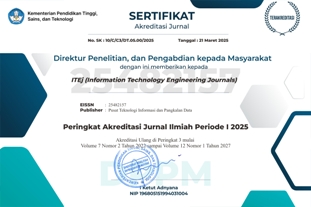Analysis of Finished Product Warehouse Activity Flow Using Lean Warehouse Method
Abstract
This company is a light steel processing manufacturing company that specializes in the production of hollow structural sections. A warehouse is the main component that enables a company's operational functions. The role of the warehouse is not only focused on storage and distribution but also on operational efficiency which can have an impact on business competitiveness. Warehousing activities at this company ain’t been optimal due to waste. Waste that occurs such as searching for empty areas for storage, waiting time for the next process, repeated product inspections, has an impact on the flow of warehousing activities. This study seeks to assess the amount of waste and provide recommendations to minimize waste within the finished product warehousing operations at this company. This study uses the Lean Warehousing method consisting of Value Stream Mapping, Process Activity Mapping, and 5 Whys Analysis. The results of this study identify 4 wasteful activities with the highest time such as waiting for the customer’s cargo truck to pick up products (I10), moving products to the truck loading bed (C5), moving products from the production floor to the storage area (S5), waiting for the next process in order to move products (P2). The proposed improvements can reduce 8 non-value-added activities and trim activity time by 1015 minutes. The suggested improvements also increase Process Cycle Efficiency by 15.32% from 11.17% to 26.49%. This proves that the implementation of lean warehouse can improve efficiency and service quality as a whole.
Downloads
References
A. Adeodu, R. Maladzhi, M. G. Kana-Kana Katumba, and I. Daniyan, “Development of an improvement framework for warehouse processes using lean six sigma (DMAIC) approach. A case of third party logistics (3PL) services,” Heliyon, vol. 9, no. 4, p. e14915, 2023, doi: 10.1016/j.heliyon.2023.e14915.
C. M. Pereira, R. Anholon, I. S. Rampasso, O. L. G. Quelhas, W. Leal Filho, and L. A. Santa-Eulalia, “Evaluation of lean practices in warehouses: an analysis of Brazilian reality,” Int. J. Product. Perform. Manag., vol. 70, no. 1, pp. 1–20, 2021, doi: 10.1108/IJPPM-01-2019-0034.
O. Voronova, “Improvement of warehouse logistics based on the introduction of lean manufacturing principles,” Transp. Res. Procedia, vol. 63, pp. 919–928, 2022, doi: 10.1016/j.trpro.2022.06.090.
D. A. Dhika, A. Witonohadi, and A. D. Akbari, “The Proposed Warehouse Improvement Using Lean Approach to Eliminate Waste at the Main Warehouse of PT. XYZ,” Opsi, vol. 16, no. 1, p. 94, 2023, doi: 10.31315/opsi.v16i1.7310.
J. P. Womack and D. T. Jones, “Lean Thinking—Banish Waste and Create Wealth in your Corporation,” J. Oper. Res. Soc., vol. 48, no. 11, pp. 1–8, 2020, doi: 10.1038/sj.jors.2600967.
I. Ledya, D. Herwanto, and A. R. Fadylla, “Usulan Rancangan Layout Gudang Menggunakan Metode Shared Storage pada PT. XYZ,” J. Asiimetrik J. Ilm. Rekayasa Inov., vol. 5, pp. 211–220, 2023, doi: 10.35814/asiimetrik.v5i2.4660.
A. irfan Samuel, A. B. H. Jan, and I. D. Palandeng, “Analisis Penerapan Manajemen Pergudangan Pada Gudang Pt Trakindo Utama Manado,” J. EMBA J. Ris. Ekon. Manajemen, Bisnis dan Akunt., vol. 11, no. 4, pp. 677–685, 2023, doi: 10.35794/emba.v11i4.51036.
A. P. Pradana, M. Chaeron, and M. S. A. Khanan, “Implementasi Konsep Lean Manufacturing Guna Mengurangi Pemborosan Di Lantai Produksi,” Opsi, vol. 11, no. 1, p. 14, 2020, doi: 10.31315/opsi.v11i1.2196.
E. Figueroa-Rivera, A. Bautista-Gonzales, and J. Quiroz-Flores, “Increased productivity of storage and picking processes in a mass-consumption warehouse applying Lean Warehousing tools: A Research in Peru,” Proc. LACCEI Int. Multi-conference Eng. Educ. Technol., vol. 2022-July, pp. 1–11, 2022, doi: 10.18687/LACCEI2022.1.1.120.
N. G. Ibrahim and Y. Prasetyawan, “Evaluasi Pergudangan dengan Pendekatan Lean Warehousing dan Linear Programming (Studi Kasus PT. X),” J. Tek. ITS, vol. 9, no. 2, pp. 278–283, 2021, doi: 10.12962/j23373539.v9i2.55529.
P. Sangga and R. Insanita, “Penerapan Praktik Lean Service Melalui Value Stream Mapping pada Departemen Food and Beverage Service Hotel X,” J. Manaj. dan Usahaw. Indones., vol. 45, no. 2, pp. 94–110, 2022.
A. F. Christie and A. Z. Al Faritzy, “Pengurangan Waste Pada Proses Produksi EQ Spacing Menggunakan Metode Lean Six Sigma,” Innov. J. Soc. Sci. …, vol. 4, pp. 18772–18785, 2024, [Online]. Available: http://j-innovative.org/index.php/Innovative/article/view/11645%0Ahttp://j-innovative.org/index.php/Innovative/article/download/11645/8665
F. Dzulkifli and D. Ernawati, “Analisa Penerapan Lean Warehousing Serta 5S Pada Pergudangan Pt. Sier Untuk Meminimasi Pemborosan,” Juminten, vol. 2, no. 3, pp. 35–46, 2021, doi: 10.33005/juminten.v2i3.243.
S. Z. N. Hasanah, D. S. Oetomo, and A. F. I. Fata, “Pemetaan Penciptaan Nilai Pada Aktivitas Pengadaan Dan Penjualan Skrap Logam Kaleng Menggunakan Value Stream Mapping Untuk Mengurangi Waste Di Pt Anisa Jaya Utama,” J. Ilm. Tek., vol. 2, no. 3, pp. 01–14, 2023, doi: 10.56127/juit.v2i3.901.
M. Riyadi, Pengendalian Produksi di Industri Galangan. Sukabumi: CV Jejak, 2020.
A. Adyatama and N. U. Handayani, “Perbaikan Kualitas Menggunakan Prinsip Kaizen Dan 5 Why Analysis: Studi Kasus Pada Painting Shop Karawang Plant 1, Pt Toyota Motor Manufacturing Indonesia,” J@ti Undip J. Tek. Ind., vol. 13, no. 3, p. 169, 2020, doi: 10.14710/jati.13.3.169-176.
V. E. Ateng, R. Rahmahwati, and Y. E. (2021). Prawatya, “Usulan Perbaikan Sistem K3 Menggunakan Metode,” J. Tek. Ind. Univ. Tanjungpura, vol. 5, no. 1, pp. 124–129, 2021.
M. N. Adjietama and N. Rahmawati, “Penerapan Konsep Lean Warehousing untuk Minimasi Pemborosan Gudang Suku Cadang dengan Metode VSM Pada PT ABC,” vol. X, no. 1, pp. 12335–12347, 2025.
R. Sanchez-Marquez, J. M. Albarracín Guillem, E. Vicens-Salort, and J. Jabaloyes Vivas, “A systemic methodology for the reduction of complexity of the balanced scorecard in the manufacturing environment,” Cogent Bus. Manag., vol. 7, no. 1, 2020, doi: 10.1080/23311975.2020.1720944.
B. John and R. S. Kadadevaramath, “Improving the resolution time performance of an application support process using Six Sigma methodology,” Int. J. Lean Six Sigma, vol. 11, no. 4, pp. 663–686, 2020, doi: 10.1108/IJLSS-10-2018-0108.









